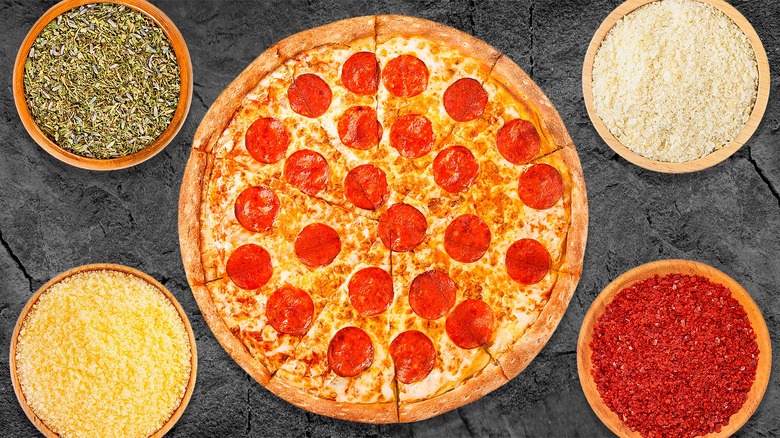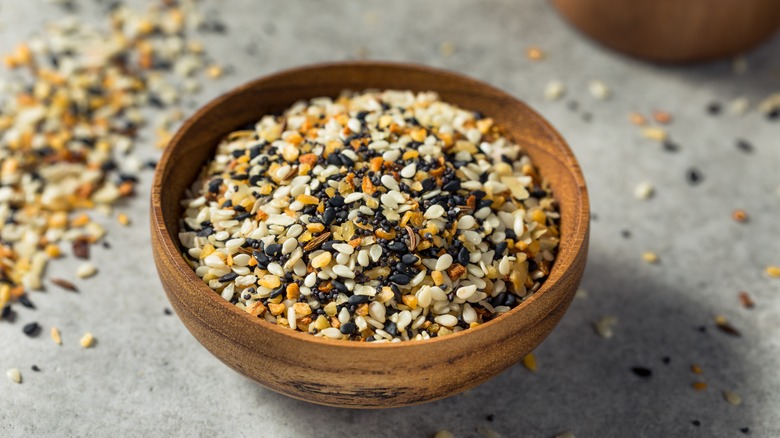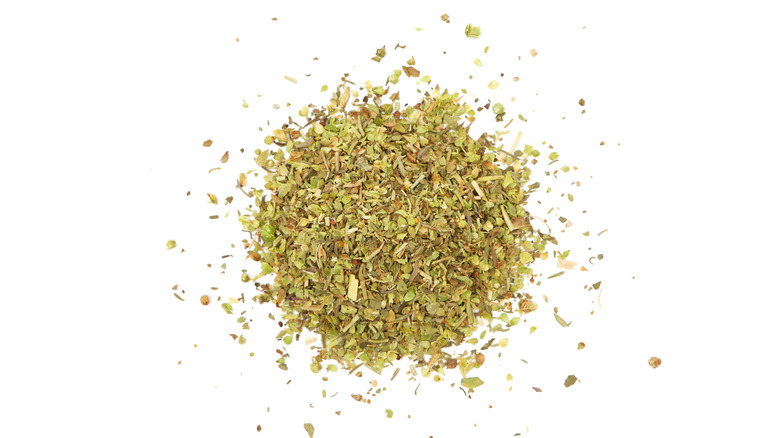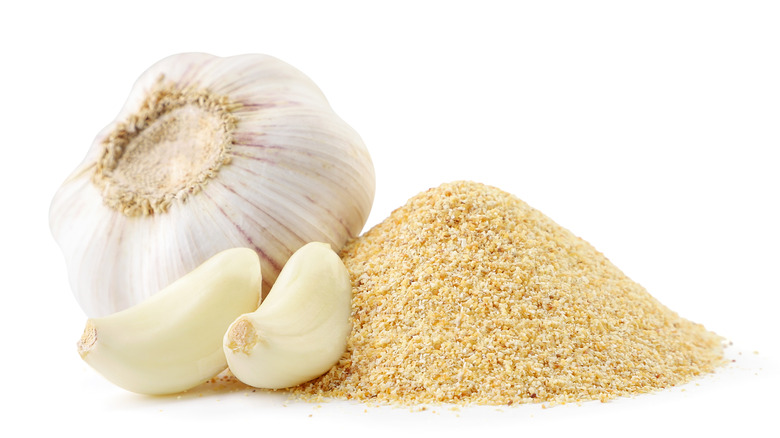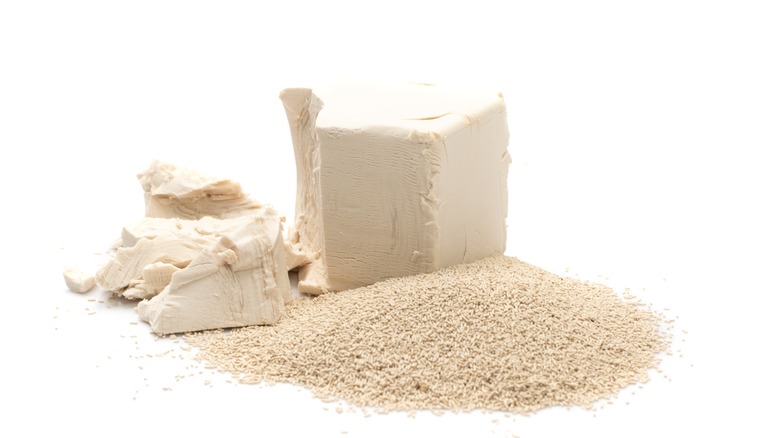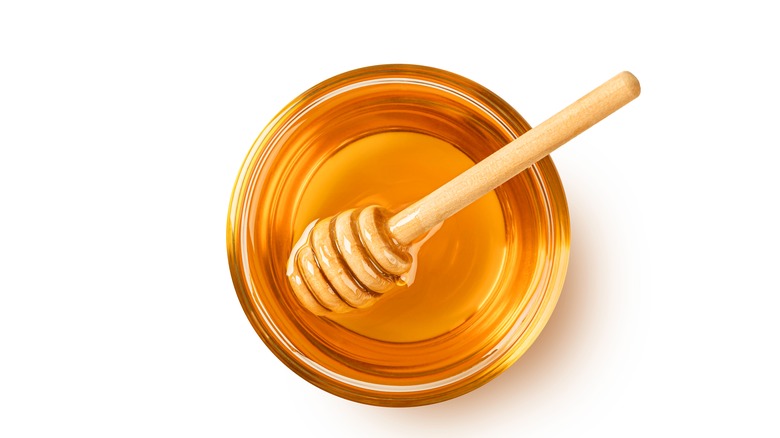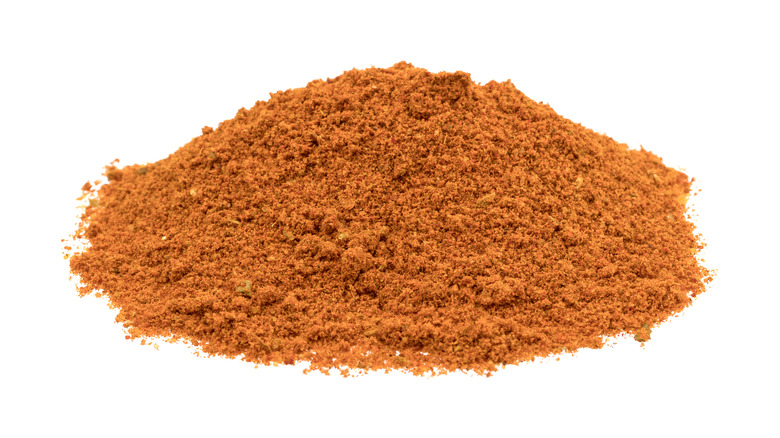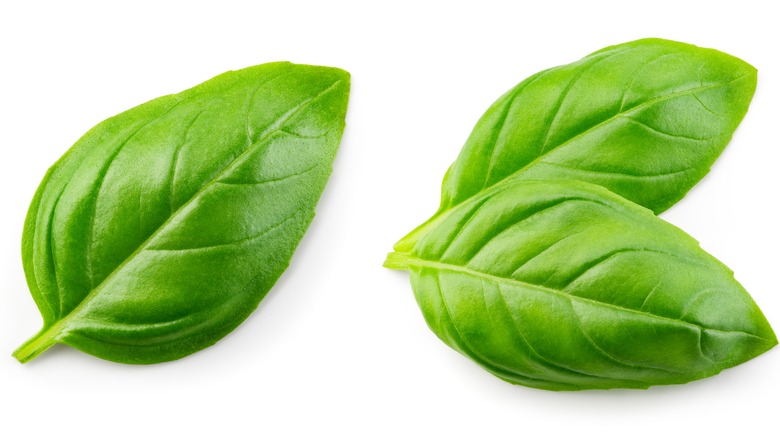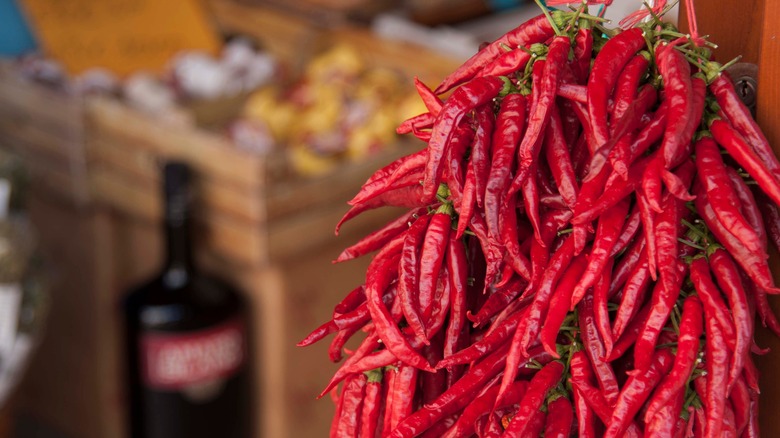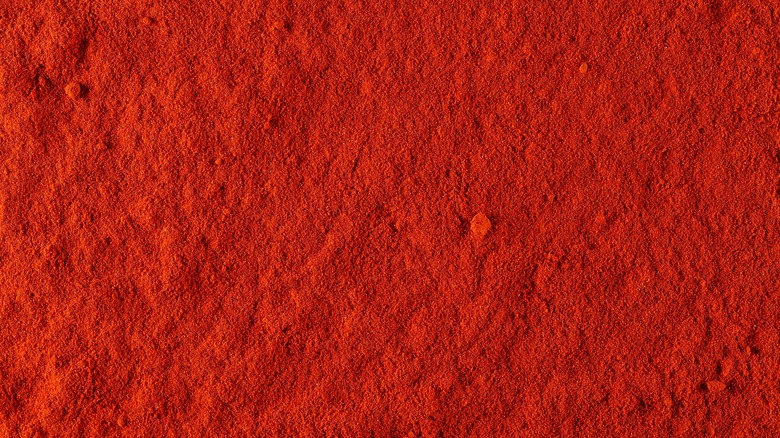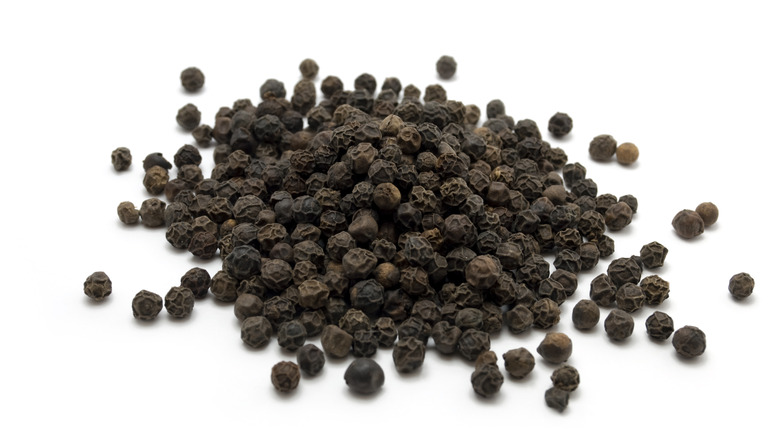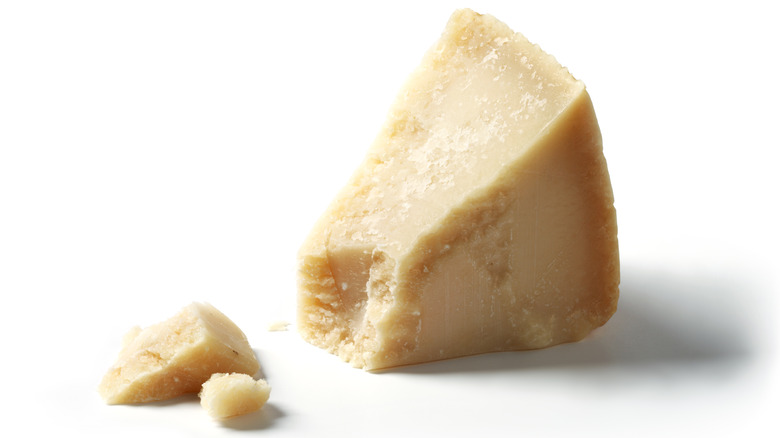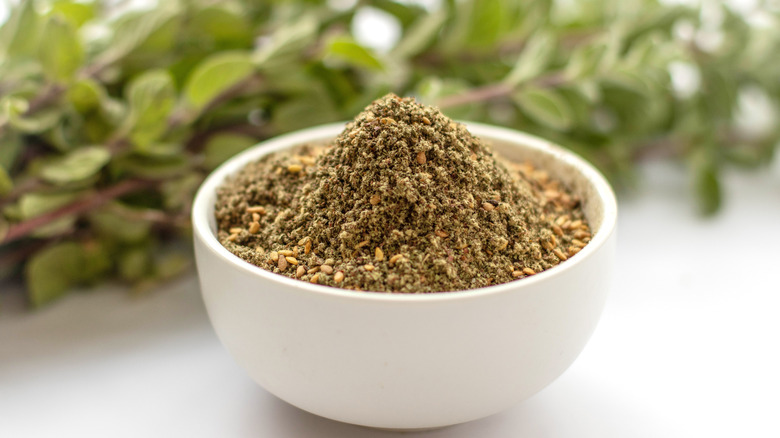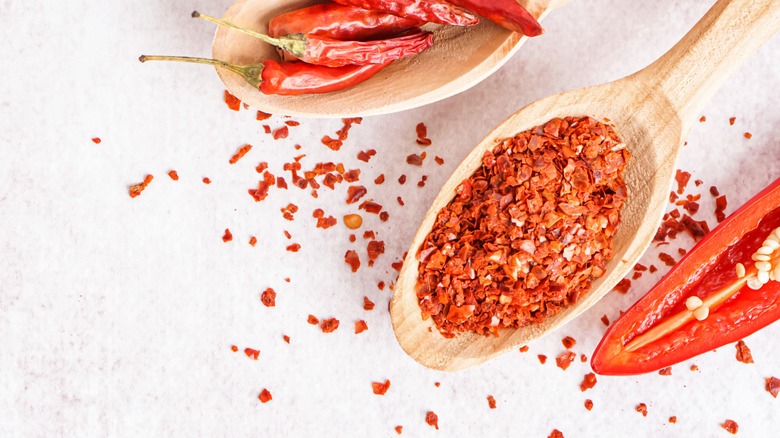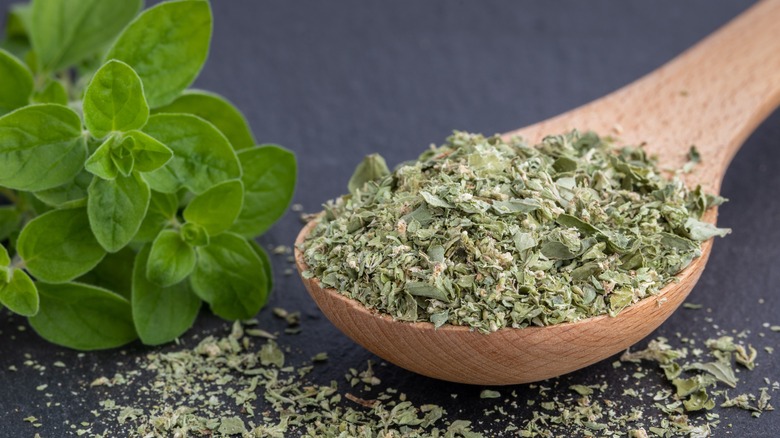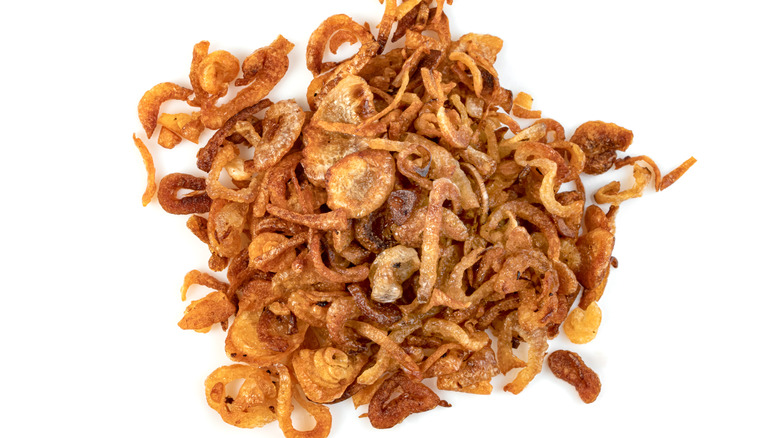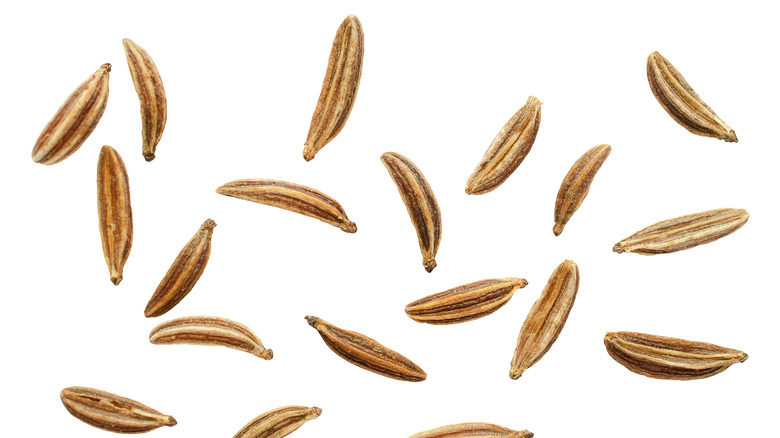17 Seasonings You Need To Sprinkle On Your Pizza
Making pizza at home can be a delicious and rewarding experience, whether you're starting from scratch, using a pre-made base, or even just doctoring up a frozen pizza. Crafting your own pie allows for creative freedom and enables you to customize your toppings, making them as commonplace or as weird and wild as you want them to be. This is your chance to put as much pineapple on your pizza as your heart desires, for example. If you're into that.
But we wouldn't recommend it. Instead, we've put together a list of spices, flavorings, and seasonings that we think you should sprinkle on your pizza next time you prepare some at home. While making the whole pizza from scratch — dough, sauce, and all — will likely yield a better flavor overall, selecting the right toppings can also transform a tired and tasteless frozen pizza into something that is downright palatable. Either way, we can help you find a few good ideas for your next pizza venture.
Everything bagel seasoning
Everything bagel seasoning has a way of going with practically anything. You can put it in your salads, on your eggs, in a sandwich — you name it. In fact, we name pizza as the next recipient of this versatile topping. The mixture combines salt, pepper, black and white sesame seeds, poppy seeds, garlic, and onion and is almost as easy to make yourself at home as it is to go out and buy it at the store.
Either way, be sure to sprinkle it on top of your favorite pizzas before they go in the oven, or you can even put it in the dough if you're making that yourself. Just don't go overboard, as pizza already contains plenty of salt on account of all that cheese. Alternatively, you could prepare the mixture at home and use less salt than usual, focusing on a high-quality flaky, or coarse salt rather than quantity.
Italian Seasoning
It's almost a no-brainer to say that one should be sprinkling Italian seasoning blends on pizza. But it bears mentioning mainly because for best results, you'll want to do more than just toss those dried leaves onto your prepared pizza. Indeed, the trick to bringing out the most flavor is to blend the seasoning into the sauce you're making so that it has time to infuse the tomato with its herby taste.
But that only goes for those times when you're making the sauce from scratch. If you're dealing with a frozen pizza, by all means, sprinkle the seasoning on top before placing the pizza in the oven. Just make sure you don't overdo it. Since the dried leaves won't have much time to blend into the sauce or cheese, as frozen pizzas typically only take 10 to 15 minutes to heat up, too much seasoning could end up overwhelming the pizza with its flavor and masking everything else.
Garlic powder
Garlic is a staple of Italian cuisine, as anyone who has ever enjoyed a good garlic bread binge will know. And while it's not typically found as a pizza topping in Italy, that doesn't mean it can't play an important role in the crafting of your own personal homemade pie. This is especially true when it comes to the sauce — adding fresh minced or crushed garlic to pizza sauce can instantly add depth of flavor.
But if you like that garlicky taste and are not a fan of the sharp spiciness that can sometimes accompany it, you can always opt for powdered garlic. Just sprinkle some in your pizza sauce and continue as usual. Alternatively, since garlic powder can dissolve pretty quickly in the oven, you can always sprinkle some on top of your pizza before cooking it. This will give your pie that extra boost without excessively altering the flavor, especially since garlic powder has a milder taste than the fresh stuff.
Nutritional yeast
Regular yeast is definitely something you should be putting into your pizza dough to produce the perfect crust and rise. But it turns out that nutritional yeast, an inactive cousin of regular yeast with a hefty flavor punch, can also totally be used to sprinkle in the pizza sauce along with dried herbs and seasoning.
The role of nutritional yeast is three-fold: First, it gives the sauce an extra layer of flavor with its cheesy notes (you may recognize this element as an ingredient used in the production of some imitation cheeses). Second, it creates a creamier texture for the tomato. And lastly, nutritional yeast, as the name suggests, comes with plenty of nutritional benefits, including antioxidants, vitamin B12, and plant protein. Once you know this trick, you'll want to use it for all your sauces–indeed it works great with lasagna and simple pasta sauce, as well.
Spicy honey
A lot of people put so much thought into what they're going to add to their pizza before it goes into the oven that they forget about those finishing touches that make all the difference. One of these is spicy honey, which works wonders on pizza when drizzled on after cooking and right before serving.
It's common in Italy to add extra virgin olive oil to pizza after it comes out of the oven. And it's not unusual to see spicy olive oil on restaurant tables to use for the same purpose. So it's not too much of a stretch to turn that spicy oil into spicy honey, which teams up to provide a lovely sweet and hot dichotomy. This is a great way to add complexity of flavor to any cheese pizza or Margherita, including frozen pizzas, which probably need the most help with a flavor boost.
Taco seasoning
Mexican pizza isn't really regular pizza at all — rather than a base of pizza dough topped with tomato sauce and mozzarella, Mexican pizza consists of two tortillas holding together ground beef, beans, and other fillings you might find in a taco or burrito. But that doesn't mean this dish doesn't have transferable skills, if you will.
That is to say that if tacos are great, and pizza is great, why not put the two together in one great big happy meal? That would be a regular Italian pizza, with sauce and cheese, plus a smattering of taco seasoning. You could stir the spices into the pizza sauce as you prepare it at home, or you could simply give your pizza a light dusting of the stuff before it goes into the oven. You can even add some diced chicken or black beans as toppings for an extra Southwestern feel.
Specialty seasoning blends
What better topping to add to pizza than a dedicated pizza seasoning? Trader Joe's has taken care of that with a new pizza seasoning it unveiled last year known as the Pizza Sprinkle Seasoning Blend.
Don't have a Trader Joe's in your area? Don't worry. The grocery store chain didn't invent this concept, it just made its own wildly popular blend. That is to say that you may be able to find other great specialty pizza seasonings blends elsewhere, through trial and error, or you can make it at home using similar ingredients, which consist mainly of tomato powder, garlic, paprika, sea salt, rice concentrate, coriander, black pepper, dried parsley, oregano, and dried basil. That may seem like a lot of mixing and matching, but remember that once you make a batch of this stuff, you can use it on any dish you can think of, not just pizza (avocado toast comes to mind).
Fresh herbs
There's something beautiful about a single leaf of fresh basil gracing the top of a hot pizza that just came out of the oven. First of all, it adds the right pop of color to balance out the red of the tomato and white of the mozzarella, which together also incidentally recreate the colors of the Italian flag. Just be sure to add the basil at the very end of cooking or even right after the pizza is completely done. Otherwise, you'll end up with a limp, not-so-fresh leaf.
And that is not the only way you can use fresh herbs on your pizza. You can also take fresh basil, oregano, and other Italian seasonings, dehydrate them in the oven, and use them on your pizza as if they were coming straight out of the jar. Just be aware that the flavors won't be as concentrated as they are in pre-dried form, so you may need to use more to achieve the same effect.
Calabrian chiles
If you like to add a spicy kick to your pizza without overwhelming it, Calabrian chiles are totally the way to go. There are two main ways in which you can do this. First, you can add the chiles in paste or chopped form to your sauce as if you were making pasta sauce, which is also complemented by this ingredient. That will give you an even distribution of flavorful spice as you spread the marinara across your dough. Just put them in the pan with your sauteing onions and garlic before adding the tomato.
Another way that requires a little less commitment is to just dot the top of your pizza with some whole or chopped Calabrian chiles in oil before placing it in the oven. In addition to the spiciness, these versatile chiles will give your pizza some smoky notes and a touch of extra acidity.
Paprika
Using spices as pizza toppings or sauce additions can be tricky. You might inadvertently combine elements that don't go together or that don't pair well with tomato, cheese, or both. Paprika is definitely not among these, in any of its multiple forms. Indeed, paprika might be the secret ingredient you've been looking for to elevate your pizza all along.
The best part is that, unlike other red pepper derivatives, you don't have to worry about using too much paprika, as long as you don't go overboard. Since it's made with dried sweet peppers and not spicy ones, its spice level remains pretty mild, though sometimes it can be mixed with cayenne pepper to make it hotter, so be mindful of that. Other varieties include smoked paprika and sweet paprika, both of which are flavorful enough on their own to be sprinkled directly on your pizza. Alternatively, you can cook it in your pizza sauce for a little to deepen the color of the sauce and further release the flavors of the paprika through the heating process.
Black pepper
Chances are that if you're making pizza at home, you're going to add salt at some part of the process. The dough may call for it and certainly the marinara sauce, while whatever cheese you include on top will naturally contain salt. But what about salt's constant companion, pepper? Where there's salt, pepper can follow, and that's as true with pizza as it is with anything.
One way to introduce pepper effectively is to make a cacio e pepe pizza, transforming the beloved Italian dish of pasta, cheese, and black pepper seamlessly into a pizza. With this recipe, you don't even need to make a sauce, so it's even simpler than making the traditional pasta dish. Just roll out your dough, drizzle olive oil on top before adding grated parmesan and pecorino, and grind some black pepper over everything to finish. If you're not making homemade pizza you can still give your meal a bit of flare by freshly grinding a hint of black pepper on any type of pizza.
Parmesan cheese
Mozzarella is the default cheese to use on pizza. Whether it's the fresh or dried variety, you can hardly go wrong with this type of cheese. But that doesn't mean you can't also branch out and substitute the mozzarella for other cheeses, or simply add to it. In either case, Parmesan is a good place to start.
The simplest way to use Parmesan on pizza is to just grate some over your sauce or your mozzarella. This alone will give a boost of flavor and saltiness to your pie. But for a deeper flavor profile, grate that Parmesan into your pizza sauce while you're still cooking it. This gives the sauce some extra umami throughout, and not just at the top. Meanwhile, the cheese will help thicken the sauce, making it creamier and easier to handle when spreading it across your dough. Another way to use parmesan on pizza is to use it as the base for a white pie, combined with a garlic, butter, and milk sauce. This makes the ultimate soft and creamy meal, as the acidity from the tomatoes is no longer in play. For best results, always use freshly grated Parmesan, as the pre-packaged stuff often contains unsavory additives.
Za'atar
For a Middle Eastern bent to your pizza, all you have to do is add some Middle Eastern spices to your pie and you'll instantly transform it into a different creature altogether. Za'atar is a particularly good choice for this move, as its combination of spices has a lot in common with Italian seasoning like oregano, though the finished flavor profile gives off very different vibes, partly due to the citrusy notes of the sumac.
While za'atar can be added to your pizza sauce like any other seasoning, it has a more finished taste than many other blends, as some of its contents are already toasted. This makes it an ideal choice to sprinkle on top of pizza, even after it comes out of the oven. More specifically, za'atar is made with toasted sesame seeds that are ground and combined with sumac, marjoram, oregano, thyme, and salt. You can simply make this at home, but za'atar is also fairly easy to find in most grocery store spice sections.
Crushed red pepper
You should always have a jar of crushed red pepper flakes in the pantry. It can be used in a wide range of recipes at any stage of the cooking process — including as a finishing touch. For instance, crushed red pepper flakes make excellent additions to pizzas and pizza sauces. Sprinkle some on top of any pizza, in moderation, before or after it goes in the oven, and you'll have an instant pop of heat.
For something more consistent throughout, incorporate the red pepper flakes into your sauce. That's where this extra-flavorful pizza recipe comes in. To make it, just saute some garlic in olive oil before adding the canned tomatoes, tomato paste, herbs, seasoning, and red pepper flakes. You can also add nutritional yeast here for a dairy-free cheesy element. As these ingredients simmer together for some 30 minutes, the flavors will mingle together, causing the spice from the red pepper flakes to fan out evenly throughout the sauce.
Oregano
Oregano is an Italian seasoning mainstay and is used widely in pasta sauces and marinara sauce for pizza. Indeed, your own pizza sauce recipe probably already calls for it, but if it doesn't, it's time to start adding it. Not only will the oregano provide some extra color and texture to your sauce, but its earthiness will give the sauce more depth of flavor, and therefore a more solid base for your mozzarella, which is an inherently mild cheese.
There are a few things you can do to help the oregano provide maximum flavor. For one, you can rub the leaves between your fingers, which will release their oils. Or you can carefully choose the type of oregano you use. Chances are, the first one you grab off the shelf is going to be a Greek variety, which is the most common. But for something more flavorful, pick Spanish or Mexican.
Dried onion
Everything bagel seasoning, which makes a great pizza topping, tends to include flaked onion. But it's also okay to want to isolate that delicious, savory flavor so that you can really taste it without having to fight off the more powerful sesame seeds and garlic. That's where flaked onions come in, or onion powder.
This is one of those ingredients that can be added either to your sauce or directly onto your pizza. In the former case, be sure to include onion powder along with your sauteed onions early on in the recipe, so it has time to infuse the sauce. In the latter instance, some crispy flaked onions will add a nice crunch to your cooked pizza, along with a milder form of its signature biting taste. Putting it on there any sooner would caused the flakes to become soggy surrounded by the moisture of the heating sauce and mozzarella.
Fennel seeds
Fennel seeds have a mild licorice-type flavor that is not usually associated with pizza. But that's exactly why you should try them next time you're rooting around through your spice cabinet looking for something to elevate your pie. This is especially true if you're planning on adding unconventional toppings to your pizza, like some form of cooked pork meat.
In particular, fennel seeds pair well with sausage and sweet and soft produce, like pumpkin slices. Be sure to cook these toppings beforehand so that they're nice and soft and bite-sized by the time they come out of the oven on your pizza. In the same vein, the fennel seeds should be included in the tomato sauce for this type of pizza, to give them a chance to permeate every inch of the pie. Sprinkling fennel seeds on top of a cooked pizza at the end might prove problematic, as the raw seeds tend to be a bit hard and pungent.
